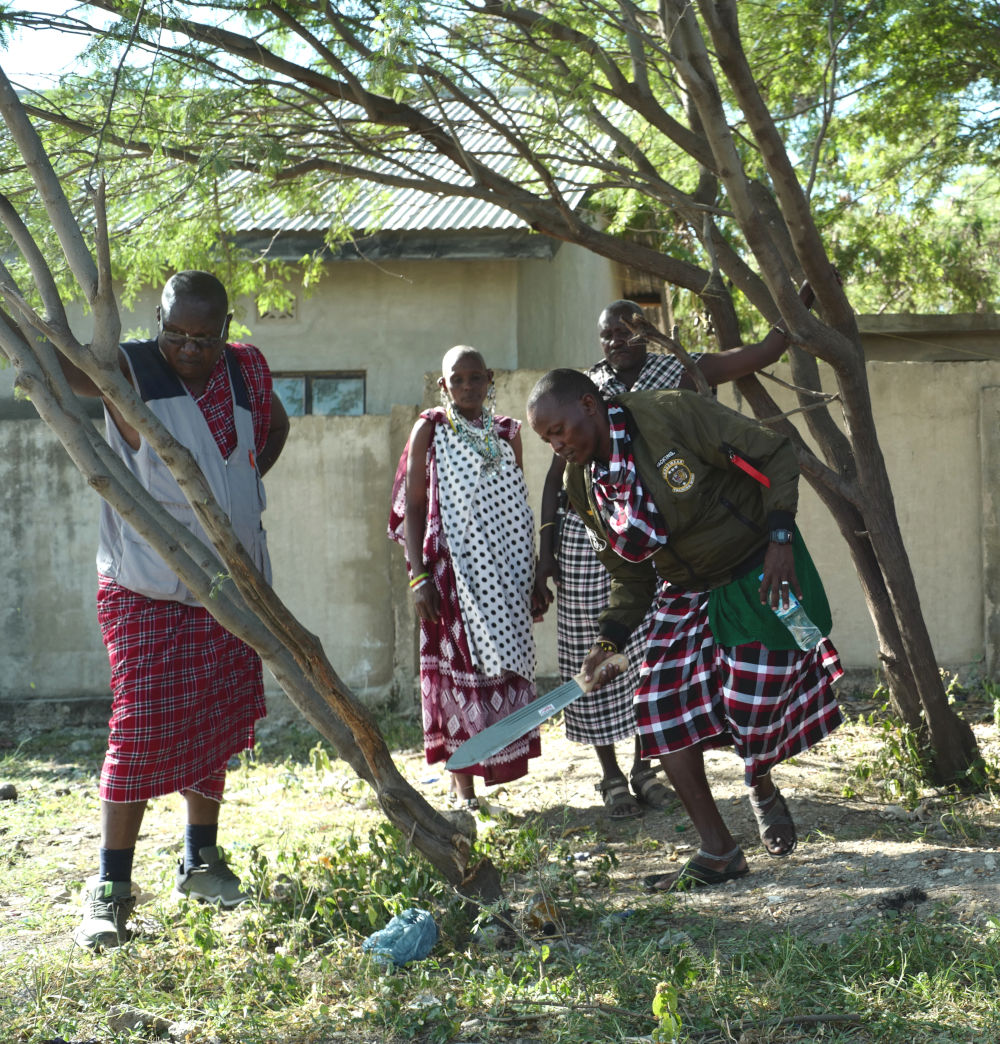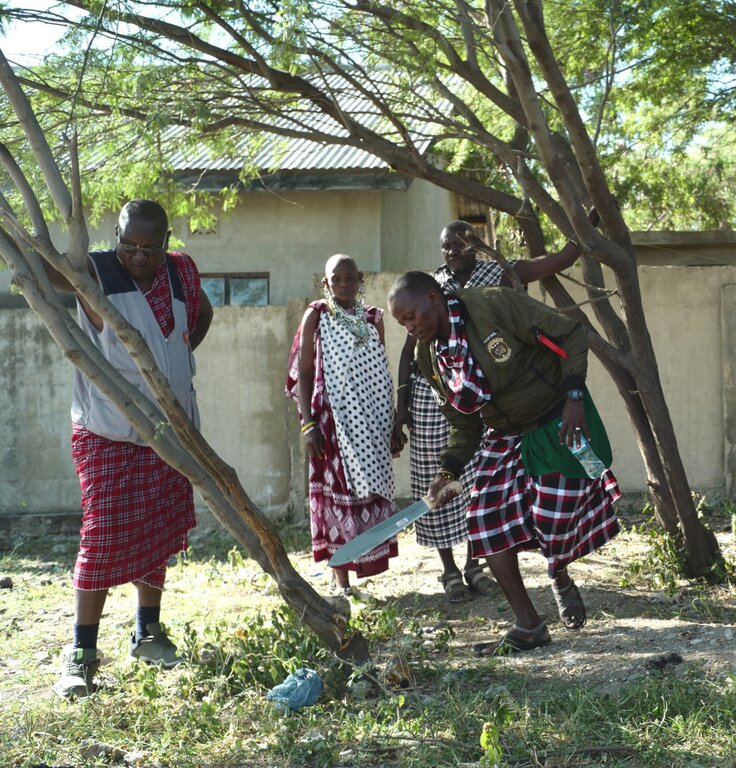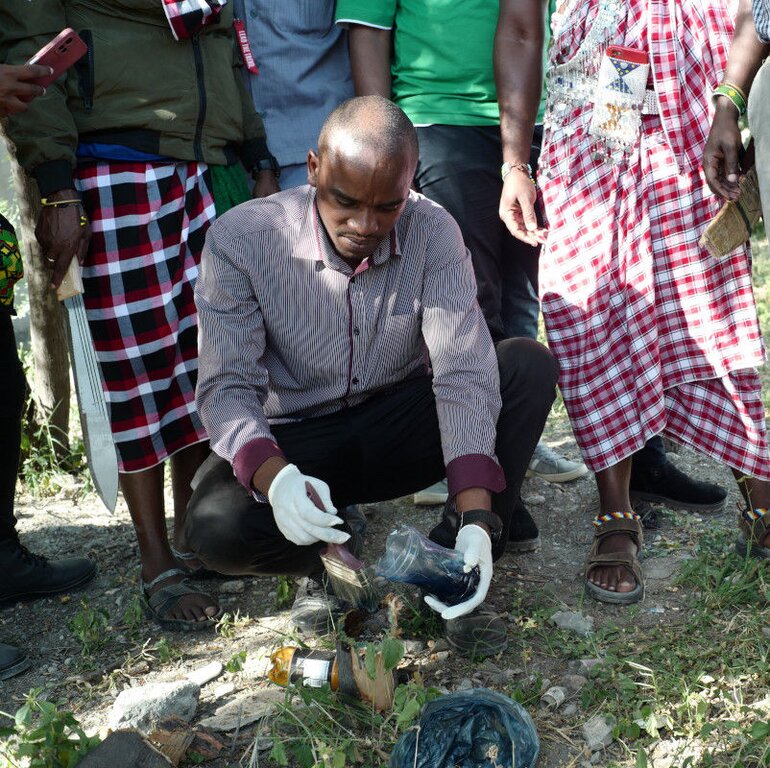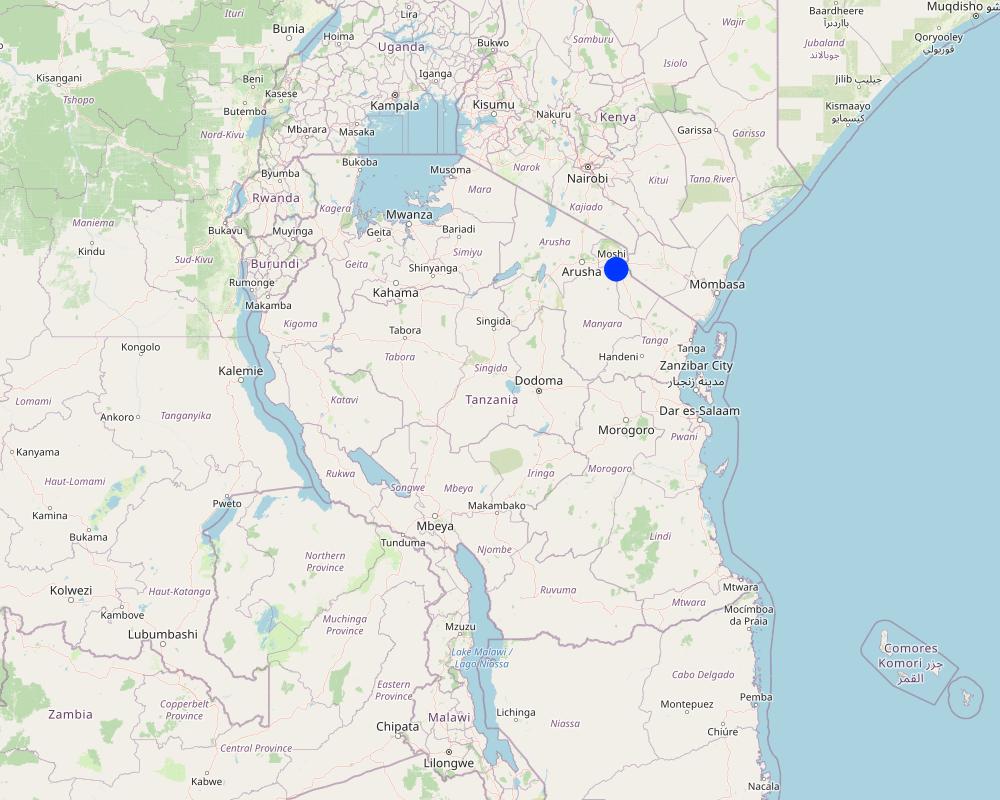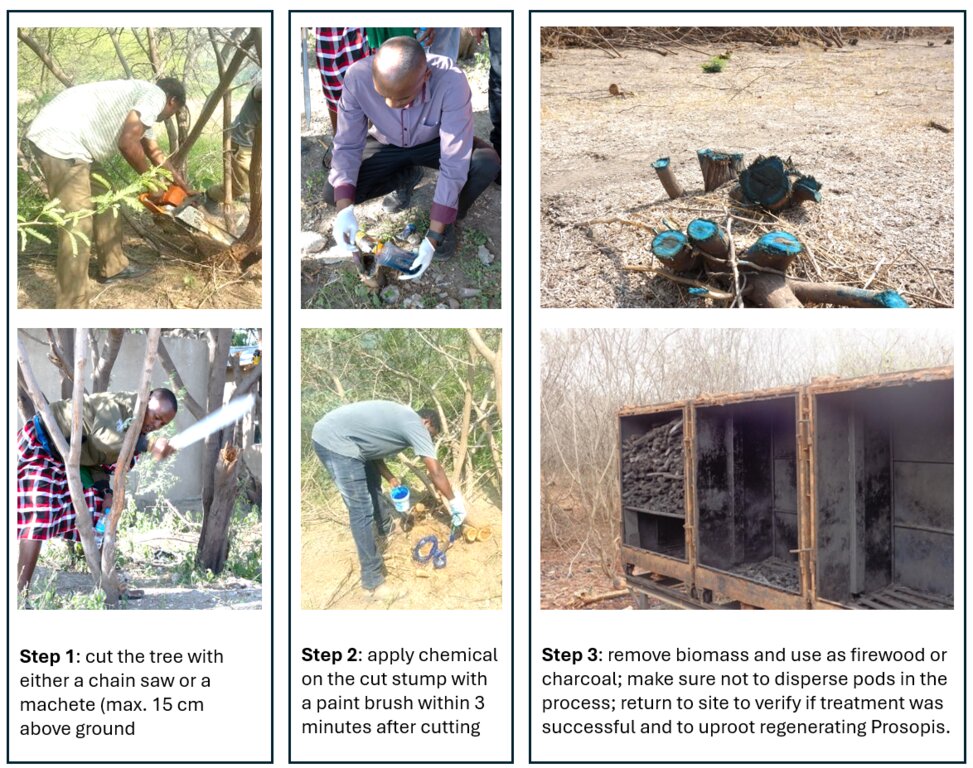Cut stump [ប្រទេសតង់សានី]
- ការបង្កើត៖
- បច្ចុប្បន្នភាព
- អ្នកចងក្រង៖ John Mbwambo
- អ្នកកែសម្រួល៖ Albrecht Ehrensperger, Beatrice Otieno
- អ្នកត្រួតពិនិត្យច្រើនទៀត៖ Christian Hergarten, Albrecht Ehrensperger
Kukata visiki
technologies_6207 - ប្រទេសតង់សានី
ពិនិត្យមើលគ្រប់ផ្នែក
ពង្រីកមើលទាំងអស់ បង្រួមទាំងអស់1. ព័ត៌មានទូទៅ
1.2 ព័ត៌មានលម្អិតពីបុគ្គលសំខាន់ៗ និងស្ថាប័នដែលចូលរួមក្នុងការវាយតម្លៃ និងចងក្រងឯកសារនៃបច្ចេកទេស
ឈ្មោះគម្រោងដែលបានចងក្រងឯកសារ/ វាយតម្លៃលើបច្ចេកទេស (បើទាក់ទង)
R4D Woody Weedsឈ្មោះអង្គភាពមួយ (ច្រើន) ដែលបានចងក្រងឯកសារ/ វាយតម្លៃបច្ចេកទេស (បើទាក់ទង)
Tanzania Forestry Research Institute (TAFORI) - ប្រទេសតង់សានីឈ្មោះអង្គភាពមួយ (ច្រើន) ដែលបានចងក្រងឯកសារ/ វាយតម្លៃបច្ចេកទេស (បើទាក់ទង)
CDE Centre for Development and Environment (CDE Centre for Development and Environment) - ប្រទេសស្វ៊ីសឈ្មោះអង្គភាពមួយ (ច្រើន) ដែលបានចងក្រងឯកសារ/ វាយតម្លៃបច្ចេកទេស (បើទាក់ទង)
CABI Switzerland (CABI Switzerland) - ប្រទេសស្វ៊ីស1.3 លក្ខខណ្ឌទាក់ទងទៅនឹងការប្រើប្រាស់ទិន្នន័យដែលបានចងក្រងតាមរយៈ វ៉ូខេត
អ្នកចងក្រង និង(បុគ្គលសំខាន់ៗ)យល់ព្រមទទួលយកនូវលក្ខខណ្ឌនានាទាក់ទងទៅនឹងការប្រើប្រាស់ទិន្នន័យដែលបានចងក្រងតាមរយៈវ៉ូខេត:
បាទ/ចា៎
1.4 សេចក្តីប្រកាសស្តីពីចីរភាពនៃការពណ៌នាពីបច្ចេកទេស
តើបច្ចេកទេសដែលបានពណ៌នានេះមានបញ្ហាដែលផ្តោតលើការធ្លាក់ចុះគុណភាពដី, បើដូច្នេះវាមិនអាចត្រូវបានប្រកាសថាជាបច្ចេកទេសនៃការគ្រប់គ្រងប្រកបដោយចីរភាពទេ?
ទេ
មតិយោបល់:
It is an SLM technology and is being tested for out-scaling in areas invaded by Prosopis juliflora
2. ការពណ៌នាពីបច្ចេកទេស SLM
2.1 ការពណ៌នាដោយសង្ខេបពីបច្ចេកទេស
និយមន័យបច្ចេកទេស:
The cut stump technology is probably the most effective means of killing mature Prosopis trees using the herbicide Triclon with active ingredients Triclopyr 480g/l . Stems are cut with a chainsaw as close to the ground as possible and the herbicide is applied to the stump within three minutes of cutting using a paintbrush. The young plants with less than 2 cm root collar diameter should be uprooted by hand. The treatment is repeated after three months on resprouting stumps.
2.2 ការពណ៌នាលម្អិតពីបច្ចេកទេស
ការពណ៌នា:
The technology is highly relevant and effective for controlling the invasion of Prosopis spp. in both agricultural and grassland areas where the species is considered problematic. It is particularly suitable for dry regions prone to Prosopis invasions, especially those experiencing drought periods of more than four months, which allow the herbicide to take significant effect. To avoid chemical contamination, the technology should only be applied in areas located more than 200 meters away from water sources.
This method requires simple tools to cut trees efficiently, with a chainsaw being recommended for the task. However, in areas where infestations cover less than 20 percent of the land, simpler tools such as machetes can be used. Trees should be cut as close to the ground as possible (no more than 15 cm stump height), and herbicide should be applied to the stump within three minutes of cutting. The treatment should be carried out during the dry season, ensuring no rainfall is expected within a month to allow for complete absorption of the herbicide.
A minimum of two people equipped with proper protective clothing is required for this operation: one to cut the trees and another to apply the herbicide and clear the cut branches. The herbicide, typically Triclopyr, is often mixed with diesel at a 1:50 ratio. A follow-up application is crucial to target any trees that were not completely killed during the initial treatment.
Herbicides can be ordered from Arysta Co. Ltd in Tanzania at a cost of TZS 1,000,000 (USD 430) per 20 liters. The advantages of using this technology include its effectiveness in killing the trees and the ability to utilize the cut branches as fuelwood or for making Prosopis charcoal. However, the major drawbacks include limited information leading to scepticism among land users regarding the health risks and potential long-term effects on soil quality, as well as the limited availability of the herbicide in local agro-stores.
2.3 រូបភាពនៃបច្ចេកទេស
កំណត់សម្គាល់ទូទៅនៃរូបថត/រូភាព:
The photograph has been added later than the documentation has taken place.
2.5 ប្រទេស/តំបន់/ទីតាំងកន្លែង ដែលបច្ចេកទេសត្រូវបានអនុវត្ត និងបានគ្រប់ដណ្តប់ដោយការវាយតម្លៃនេះ
ប្រទេស:
ប្រទេសតង់សានី
តំបន់/រដ្ឋ/ខេត្ត:
Kilimanjaro
បញ្ជាក់បន្ថែមពីលក្ខណៈនៃទីតាំង:
Kahe
បញ្ជាក់ពីការសាយភាយនៃបច្ចេកទេស:
- អនុវត្តនៅកន្លែងជាក់លាក់មួយ/ ប្រមូលផ្តុំនៅតំបន់តូចៗ
តើបច្ចេកទេស (មួយ ឬច្រើន) ទាំងនោះស្ថិតនៅក្នុងតំបន់ការពារជាអចិន្ត្រៃយ៍ណាមួយដែរឬទេ?
ទេ
Map
×2.6 កាលបរិច្ឆេទនៃការអនុវត្ត
បង្ហាញឆ្នាំនៃការចុះអនុវត្ត:
2017
ប្រសិនបើមិនច្បាស់ឆ្នាំ សូមបញ្ជាក់កាលបរិច្ឆេទដែលប្រហាក់ប្រហែល:
- តិចជាង 10ឆ្នាំមុន (ថ្មី)
2.7 ការណែនាំពីបច្ចេកទេស
សូមបញ្ជាក់តើបច្ចេកទេសត្រូវបានណែនាំឱ្យអនុវត្តដោយរបៀបណា:
- ពេលកំពុងពិសោធន៍
មតិយោបល់ (ប្រភេទនៃគម្រោង ។ល។):
The technology was introduced through experimentation during the implementation of the Woody Weeds Project. For more details visit www.woodyweeds.org
3. ចំណាត់ថ្នាក់នៃបច្ចេកទេស SLM
3.1 គោលបំណងចម្បង (១ ឬច្រើន) នៃបច្ចេកទេសនេះ
- ធ្វើឱ្យប្រសើរឡើងនូវផលិតកម្ម
- កាត់បន្ថយ, បង្ការ, ស្តារឡើងវិញនូវការធ្លាក់ចុះគុណភាពដី
- អភិរក្សប្រព័ន្ធអេកូឡូស៊ី
- អភិរក្ស/ធ្វើឱ្យប្រសើរឡើងជីវចម្រុះ
- បង្កើតផលប្រយោជន៍សង្គម
3.2 ប្រភេទដីប្រើប្រាស់មួយប្រភេទ (ច្រើនប្រភេទ) ដែលបានអនុវត្តបច្ចេកទេស
ដីប្រើប្រាស់ចម្រុះនៅលើដីតែមួយ:
បាទ/ចា៎
បញ្ជាក់ពីប្រភេទដីច្រើនប្រភេទ (ដីដាំដំណាំ/ដីចិញ្ចឹមសត្វ/ដីព្រៃឈើ):
- Agro-pastoralism ( រួមបញ្ចូលទាំងដំណាំ និងចិញ្ចឹមសត្វ)

ដីដាំដំណាំ
- ដំណាំប្រចាំឆ្នាំ
ដំណាំប្រចាំឆ្នាំ - បញ្ជាក់ប្រភេទដំណាំ:
- ធញ្ញជាតិ - ពោត
- បន្លែ - ផ្សេងៗ
ប្រព័ន្ធដាំដុះដំណាំប្រចាំឆ្នាំ:
ដាំដំណាំបន្លែបន្តបន្ទាប់
តើជាការអនុវត្តន៍ដំណាំចន្លោះ?
បាទ/ចា៎
ប្រសិនបើបាទ/ច៎ា សូមបញ្ជាក់ប្រភេទដំណាំដែលដាំចន្លោះគ្នានោះ:
Maize and tomato, Maize and black nightshade
តើជាការអនុវត្តន៍ដំណាំវិលជុំ?
បាទ/ចា៎
បើបាទ/ច៎ា សូមបញ្ជាក់:
Maize with tomato, black nightshade with bell peppers

ដីសម្រាប់ចិញ្ចឹមសត្វ
វាលស្មៅធំៗ:
- Transhumant pastoralism
តើជាការអនុវត្តការគ្រប់គ្រងដែលរួមបញ្ចូលការដាំដំណាំ និងចិញ្ចឹមសត្វដែរឬទេ?
បាទ/ចា៎
បើបាទ/ច៎ា សូមបញ្ជាក់:
Livestock are released to graze around fenced farmlands or graze/feed on stalks left after harvests.
ផលិតផល និងសេវាកម្ម:
- សាច់
ប្រភេទពូជ:
សត្វពាហនៈ - សត្វចិញ្ចឹមមិនយកទឹកដោះតែសម្រាប់យកសាច់
ចំនួន:
10
មតិយោបល់:
Crop cultivation and grazing are rotated to avoid crop damage and sometimes cropland is fenced with thorny branches of Prosopis juliflora to deter livestock from accessing the crop fields.
3.3 បន្ទាប់ពីអនុវត្តបច្ចេកទេស តើដីប្រើប្រាស់មានការប្រែប្រួលដែររឺទេ?
បន្ទាប់ពីអនុវត្តបច្ចេកទេស តើដីប្រើប្រាស់មានការប្រែប្រួលដែររឺទេ?
- ទេ (បន្តទៅសំណួរ 3.4)
ដីប្រើប្រាស់ចម្រុះនៅលើដីតែមួយ:
បាទ/ចា៎
បញ្ជាក់ពីប្រភេទដីច្រើនប្រភេទ (ដីដាំដំណាំ/ដីចិញ្ចឹមសត្វ/ដីព្រៃឈើ):
- Agro-pastoralism ( រួមបញ្ចូលទាំងដំណាំ និងចិញ្ចឹមសត្វ)

ដីដាំដំណាំ
- ដំណាំប្រចាំឆ្នាំ
ប្រព័ន្ធដាំដុះដំណាំប្រចាំឆ្នាំ:
ដាំដំណាំបន្លែបន្តបន្ទាប់
តើជាការអនុវត្តន៍ដំណាំចន្លោះ?
បាទ/ចា៎
ប្រសិនបើបាទ/ច៎ា សូមបញ្ជាក់ប្រភេទដំណាំដែលដាំចន្លោះគ្នានោះ:
Maize and tomato, Maize and black nightshade
តើជាការអនុវត្តន៍ដំណាំវិលជុំ?
បាទ/ចា៎
បើបាទ/ច៎ា សូមបញ្ជាក់:
Maize with tomato, black nightshade with bell peppers

ដីសម្រាប់ចិញ្ចឹមសត្វ
វាលស្មៅធំៗ:
- Transhumant pastoralism
មតិយោបល់:
Crop cultivation and grazing are rotated to avoid crop damage and sometimes cropland is fenced with thorny branches of Prosopis juliflora to deter livestock from accessing the crop fields.
3.4 ការផ្គត់ផ្គង់ទឹក
ការផ្គត់ផ្គង់ទឹកនៅកន្លែងអនុវត្តបច្ចេកទេស:
- ទឹកភ្លៀង និងប្រព័ន្ធស្រោចស្រព
មតិយោបល់:
Cultivation of vegetables relies fully on irrigation. Water is obtained from shallow bore holes and pumped out to irrigate the fields.
3.5 ក្រុម SLM ដែលបច្ចេកទេសស្ថិតនៅក្នុង
- Weed control and management
3.6 វិធានការ SLM ដែលបញ្ចូលនូវបច្ចេកទេស

វិធានការគ្រប់គ្រង
- M5: គ្រប់គ្រង/ ការប្លាស់ប្តូរសមាសភាពពូជ
មតិយោបល់:
The cut stump technology is considered a control of species composition because the intention is to remove or reduce the abundance of the invasive species and improve performance of desired native plant species.
3.7 កំណត់ប្រភេទនៃការធ្លាក់ចុះគុណភាពដីសំខាន់ៗដែលបច្ចេកទេសនេះបានដោះស្រាយ

ការធ្លាក់ចុះជីវសាស្ត្រនៃដី
- Bs: សមាសភាពដែលមានគុណភាពនិងប្រភេទសត្វ/ការថយចុះនូវជីវចម្រុះ
មតិយោបល់:
The technology controls and reduces the density of an invasive tree Prosopis juliflora on grazing land and cultivated fields.
3.8 ការពារ កាត់បន្ថយ ឬស្តារឡើងវិញនៃការធ្លាក់ចុះគុណភាពដី
បញ្ជាក់ពីគោលដៅរបស់បច្ចេកទេស ដែលផ្តោតទៅការធ្លាក់ចុះគុណភាពដី:
- ការជួសជុល/ ស្តារឡើងវិញនៃឱនភាពដីធ្ងន់ធ្ងរ
មតិយោបល់:
The land degradation is due to change of vegetation cover as a result of increasing abundance of an invasive tree.
4. បច្ចេកទេសជាក់លាក់ សកម្មភាពអនុវត្ត ធាតុចូល និងថ្លៃដើម
4.1 គំនូសបច្ចេកទេសនៃបច្ចេកទេសនេះ
លក្ខណៈពិសេសនៃបច្ចេកទេស (ទាក់ទងនឺងគំនូរបច្ចេកទេស):
Stems of Prosopis should be cut very close to the ground (ca. 15 cm from the ground)
ឈ្មោះអ្នកនិពន្ធ:
Albrecht Ehrensperger (based on photos from different authors)
កាលបរិច្ឆេទ:
03/07/2024
4.2 ព័ត៌មានទូទៅដែលពាក់ព័ន្ធនឹងការគណនាធាតុចូល និងថ្លៃដើម
កំណត់របៀបនៃការគណនាថ្លៃដើម និងធាតុចូល:
- ក្នុងតំបន់អនុវត្តបច្ចេកទេស
កំណត់ទំហំ និងឯកត្តាផ្ទៃដី:
0.01 Hectares
ផ្សេងៗ/ រូបិយប័ណ្ណជាតិ (បញ្ជាក់):
Tanzanian Shilling
បើពាក់ព័ន្ធសូមកំណត់អត្រាប្តូរប្រាក់ពីដុល្លាទៅរូបិយប័ណ្ណតំបន់ (ឧ. 1 ដុល្លារ = 79.9 រៀលនៃរូបិយប័ណ្ណប្រេស៊ីល) ៖ 1 ដុល្លារ =:
2400,0
កំណត់ថ្លៃឈ្នួលជាមធ្យមនៃការជួលកម្លាំងពលកម្មក្នុងមួយថ្ងៃ:
20,000
4.3 សកម្មភាពបង្កើត
| សកម្មភាព | រយៈពេល (រដូវកាល) | |
|---|---|---|
| 1. | Acquisition of Chemical (Triclon) | anytime of the year |
| 2. | Hiring a Chain Saw | anytime of the year |
| 3. | Cutting of stems | During dry season (normally January - March) |
| 4. | Chemical application using paint brush | Within five minutes after cutting the stems |
| 5. | Separating intertwined branches | Immediately after cutting the stems |
| 6. | Cleaning the area from thorns and small branches | Immediately after cutting the stems |
| 7. | 2nd treatments of stumps | Two months after chemical treatments and during dry season |
| 8. | 3rd treatment of stumps | After 6-8 months after 1st treatment and should be during dry season (normally September - October) |
| 9. | Removing regenerating Prosopis | Every three months after 1st treatment for 15 months |
មតិយោបល់:
It is important to find out which chemical is registered for use in your area. Triclopyr was easy to use and very effective to kill trees with stem diameter > 5cm.
4.4 ថ្លៃដើម និងធាតុចូលដែលត្រូវការសម្រាប់ការបង្កើតបច្ចេកទេស
| បញ្ជាក់ពីធាតុចូល | ឯកតា | បរិមាណ | ថ្លៃដើមក្នុងមួយឯកតា | ថ្លៃធាតុចូលសរុប | % នៃថ្លៃដើមដែលចំណាយដោយអ្នកប្រើប្រាស់ដី | |
|---|---|---|---|---|---|---|
| កម្លាំងពលកម្ម | Cutting of stems | Mandays | 2,0 | 20000,0 | 40000,0 | |
| កម្លាំងពលកម្ម | Chemical application using paint brush | Mandays | 1,0 | 20000,0 | 20000,0 | |
| កម្លាំងពលកម្ម | Separating intertwined branches | Mandays | 2,0 | 20000,0 | 40000,0 | |
| កម្លាំងពលកម្ម | Removing small branches and debris | Mandays | 1,0 | 20000,0 | 20000,0 | |
| សម្ភារៈ | Hiring a Chain saw | Hours | 8,0 | 4000,0 | 32000,0 | |
| ជី និងសារធាតុពុល | Triclon (480g/l Triclopyr) | Litres | 1,2 | 50000,0 | 60000,0 | |
| ថ្លៃដើមសរុបក្នុងការបង្កើតបច្ចេកទេស | 212000,0 | |||||
| ថ្លៃដើមសរុបក្នុងការបង្កើតបច្ចេកទេសគិតជាដុល្លារ | 88,33 | |||||
ប្រសិនបើអ្នកប្រើប្រាស់ដីមិនមានថ្លៃដើម 100% សូមបញ្ជាក់ថានរណាដែលចំណាយថ្លៃដើមដែលនៅសល់:
R4D Woody Weeds Project
មតិយោបល់:
The estimated costs is for an area covered with > 80 Prosopis juliflora. The technology has not yet been out-scaled. The main challenge with its adoption is the availability of the chemical Triclon.
4.5 សកម្មភាពថែទាំ
| សកម្មភាព | ពេលវេលា/ ភាពញឹកញាប់ | |
|---|---|---|
| 1. | Uprooting regenerating Prosopis | after every three months |
| 2. | Chemical application | Every dry season up to 15 months |
មតិយោបល់:
To ensure effective control it is important to uproot all regenerating Prosopis after every three months.
4.6 កំណត់ថ្លៃដើមសម្រាប់ការថែទាំ/ សកម្មភាពរបស់បច្ចេកទេស (ក្នុងរយៈពេលមួយឆ្នាំ)
| បញ្ជាក់ពីធាតុចូល | ឯកតា | បរិមាណ | ថ្លៃដើមក្នុងមួយឯកតា | ថ្លៃធាតុចូលសរុប | % នៃថ្លៃដើមដែលចំណាយដោយអ្នកប្រើប្រាស់ដី | |
|---|---|---|---|---|---|---|
| កម្លាំងពលកម្ម | uprooting regenerating Prosopis | Mandays | 5,0 | 20000,0 | 100000,0 | |
| ជី និងសារធាតុពុល | Triclon (triclopyr 480g/L) | Litres | 0,6 | 50000,0 | 30000,0 | |
| ថ្លៃដើមសរុបសម្រាប់ការថែទាំដំណាំតាមបច្ចេកទេស | 130000,0 | |||||
| ថ្លៃដើមសរុបសម្រាប់ការថែទាំដំណាំតាមបច្ចេកទេសគិតជាដុល្លារ | 54,17 | |||||
ប្រសិនបើអ្នកប្រើប្រាស់ដីមិនមានថ្លៃដើម 100% សូមបញ្ជាក់ថានរណាដែលចំណាយថ្លៃដើមដែលនៅសល់:
R4D Woody Weeds
មតិយោបល់:
After every three months, uprooting of all regenerating Prosopis should be done before they develop deep roots and start competing with desired plants.
4.7 កត្តាសំខាន់បំផុតដែលមានឥទ្ធិពលដល់ការចំណាយ
ពណ៌នាពីកត្តាប៉ះពាល់ចម្បងៗទៅលើថ្លៃដើម:
(i) Availability of labor during farming seasons
(ii) Distance from and availability of agro-chemical stores
(iii) Size of Prosopis trees
(iv) Length of dry and wet seasons (long wet season makes many seed of Prosopis to germinate and long dry season makes it difficult to work out under the sun)
5. លក្ខណៈបរិស្ថានធម្មជាតិ និងមនុស្ស
5.1 អាកាសធាតុ
បរិមាណទឹកភ្លៀងប្រចាំឆ្នាំ
- < 250 មម
- 251-500 មម
- 501-750 មម
- 751-1,000 មម
- 1,001-1,500 មម
- 1,501-2,000 មម
- 2,001-3,000 មម
- 3,001-4,000 មម
- > 4,000 មម
កំណត់បរិមាណទឹកភ្លៀង (បើដឹង) ជា មីលីម៉ែត្រ:
400,00
លក្ខណៈពិសេស/ មតិយោបល់លើរដូវភ្លៀង:
Extended dry seasons from September to mid-March. Bi-annual rainfall, with most rain falling from April to Mid and short rains from Mid November to December.
បញ្ជាក់ឈ្មោះឯកសារយោងនៃស្ថានីយឧតុនិយម:
TPC Sugar Manufacturing Company
តំបន់កសិអាកាសធាតុ
- មានភ្លៀងតិចតួច
The area is very dry and agriculture is only possible through irrigation. Temperatures are very high during the day, at about 30 degrees Celcius. However, domestic animals such as cattle, goats, and sheep thrive fairly well in the area and there is very good hay during rainy seasons.
5.2 សណ្ឋានដី
ជម្រាលជាមធ្យម:
- រាបស្មើ (0-2%)
- ជម្រាលតិចតួច (3-5%)
- មធ្យម (6-10%)
- ជម្រាលខ្ពស់បន្តិច (11-15%)
- ទីទួល (16-30%)
- ទីទួលចោត (31-60%)
- ទីទួលចោតខ្លាំង (>60%)
ទម្រង់ដី:
- ខ្ពង់រាប
- កំពូលភ្នំ
- ជម្រាលភ្នំ
- ជម្រាលទួល
- ជម្រាលជើងភ្នំ
- បាតជ្រលងភ្នំ
តំបន់តាមរយៈកម្ពស់ :
- 0-100 ម
- 101-500 ម
- 501-1,000 ម
- 1,001-1,500 ម
- 1,501-2,000 ម
- 2,001-2,500 ម
- 2,501-3,000 ម
- 3,001-4,000 ម
- > 4,000 ម
បញ្ជាក់ថាតើបច្ចេកទេសនេះត្រូវបានអនុវត្តន៍នៅក្នុង:
- មិនពាក់ព័ន្ធទាំងអស់
មតិយោបល់ និងបញ្ចាក់បន្ថែមអំពីសណ្ឋានដី :
Extensive flat terrain interrupted by seasonal rivers flowing southeast of the Kilimanjaro Mountains. There are big acacia (mainly Vachelia xanthophloea) and fig trees along the seasonal rivers and anthills far away from rivers where floods are unlikely.
5.3 ដី
ជម្រៅដីជាមធ្យម:
- រាក់ខ្លាំង (0-20 សម)
- រាក់ (21-50 សម)
- មធ្យម (51-80 សម)
- ជ្រៅ (81-120 សម)
- ជ្រៅខ្លាំង (> 120 សម)
វាយនភាពដី (ស្រទាប់លើ):
- មធ្យម (ល្បាយ, ល្បាប់)
វាយនភាពដី (> 20 សម ស្រទាប់ក្នុង):
- មធ្យម (ល្បាយ, ល្បាប់)
សារធាតុសរីរាង្គនៅស្រទាប់ដីខាងលើ:
- ខ្ពស់ (>3%)
បើអាចសូមភ្ជាប់ការពណ៌នាពីដីឱ្យបានច្បាស់ ឬព័ត៌មានដែលអាចទទួលបាន ឧ. ប្រភេទដី, pH ដី/ ជាតិអាស៊ីត, សមត្ថភាពផ្លាស់ប្តូរកាចុង, វត្តមាននីត្រូសែន, ភាពប្រៃ ។ល។:
See attached soil information that was taken before implementation of the Cut Stump at Kahe, Kilimanjaro Tanzania
5.4 ទឹកដែលអាចទាញមកប្រើប្រាស់បាន និងគុណភាពទឹក
នីវ៉ូទឹកក្រោមដី:
5-50 ម
ទឹកលើដីដែលអាចទាញយកប្រើប្រាស់បាន:
កម្រិតមធ្យម
គុណភាពទឹក (មិនបានធ្វើប្រត្តិកម្ម):
ទឹកសម្រាប់តែការធ្វើកសិកម្ម (ស្រោចស្រព)
គុណភាពទឹក គឺផ្តោតទៅលើ៖:
ទឹកក្រោមដី
តើមានបញ្ហាភាពទឹកប្រៃហូរចូលមកដែរឬទេ?
បាទ/ចា៎
សូមបញ្ជាក់:
Continuous irrigation from underground waters increases salinity and makes farms unproductive thus necessitate rotational cropping and woody trees
តើទឹកជំនន់កំពុងកើតមាននៅតំបន់នេះដែររឺទេ?
បាទ/ចា៎
ភាពទៀងទាត់:
ញឹកញាប់
មតិយោបល់ និងលក្ខណៈពិសេសផ្សេងៗទៀតលើគុណភាព និងបរិមាណទឹក :
The underground water recharges quickly after rain seasons but due to limited vegetation cover, the rate of evapotranspiration is high thus the water remaining in the ground is very little.
5.5 ជីវៈចម្រុះ
ភាពសម្បូរបែបនៃប្រភេទ:
- ទាប
ភាពសម្បូរបែបនៃទីជម្រក:
- ទាប
មតិយោបល់ និងលក្ខណៈពិសេសផ្សេងទៀតលើជីវចម្រុះ:
Typical diversity of continuous cultivated areas
5.6 លក្ខណៈនៃអ្នកប្រើប្រាស់ដីដែលអនុវត្តបច្ចេកទេស
នៅមួយកន្លែង ឬពនេចរ :
- ពាក់កណ្តាលពនេចរ
ទីផ្សារនៃប្រព័ន្ធផលិតកម្ម:
- ពាក់កណ្តាលពាណិជ្ជកម្ម (ផ្គត់ផ្គង់ខ្លួនឯង/ ពាណិជ្ជកម្ម)
ចំណូលក្រៅកសិកម្ម:
- 10-50% នៃចំណូល
កម្រិតជីវភាព:
- មធ្យម
ឯកជន ឬក្រុម:
- ធ្វើខ្លួនឯង/ គ្រួសារ
កម្រិតប្រើប្រាស់គ្រឿងយន្ត:
- ប្រើកម្លាំងពលកម្ម
យេនឌ័រ:
- ស្ត្រី
អាយុរបស់អ្នកប្រើប្រាស់ដី:
- វ័យកណ្តាល
5.7 ទំហំផ្ទៃដីជាមធ្យមនៃដីប្រើប្រាស់ដោយអ្នកប្រើប្រាស់ដី ក្នុងការអនុវត្តបច្ចេកទេស
- < 0.5 ហិកតា
- 0.5-1 ហិកតា
- 1-2 ហិកតា
- 2-5 ហិកតា
- 5-15 ហិកតា
- 15-50 ហិកតា
- 50-100 ហិកតា
- 100-500 ហិកតា
- 500-1,000 ហិកតា
- 1,000-10,000 ហិកតា
- > 10,000 ហិកតា
5.9 ការប្រើប្រាស់សេវាកម្ម និងហេដ្ឋារចនាសម្ព័ន្ធ
សុខភាព:
- មិនល្អ
- មធ្យម
- ល្អ
ការអប់រំ:
- មិនល្អ
- មធ្យម
- ល្អ
ជំនួយបច្ចេកទេស:
- មិនល្អ
- មធ្យម
- ល្អ
ការងារ (ឧ. ការងារក្រៅកសិដ្ឋាន):
- មិនល្អ
- មធ្យម
- ល្អ
ទីផ្សារ:
- មិនល្អ
- មធ្យម
- ល្អ
ថាមពល:
- មិនល្អ
- មធ្យម
- ល្អ
ផ្លូវ និងការដឹកជញ្ជូន:
- មិនល្អ
- មធ្យម
- ល្អ
ទឹកផឹក និងអនាម័យ:
- មិនល្អ
- មធ្យម
- ល្អ
សេវាកម្មហិរញ្ញវត្ថុ:
- មិនល្អ
- មធ្យម
- ល្អ
6. ផលប៉ះពាល់ និងការសន្និដ្ឋាន
6.1 ផលប៉ះពាល់ក្នុងបរិវេណអនុវត្តបច្ចេកទេសដែលកើតមាន
ផលប៉ះពាល់លើសេដ្ឋកិច្ចសង្គម
ផលិតផល
ផលិតកម្មដំណាំ
គុណភាពមុន SLM:
1 t/ha of maize
គុណភាពក្រោយ SLM:
1.5 t/ha of Maize
មតិយោបល់/ ការបញ្ជាក់:
A significant increase was seen in maize production but also the production of tomatoes increased by about 25%.
ផលិតកម្មចំណីសត្វ
គុណភាពមុន SLM:
4 loads@ 10kg
គុណភាពក្រោយ SLM:
15 loads@ 10kg
មតិយោបល់/ ការបញ្ជាក់:
A significant increase in fodder production due to reduced competition with Prosopis and increased production area.
ផលិតកម្មឈើ
គុណភាពមុន SLM:
30 bags @ 20kg
គុណភាពក្រោយ SLM:
0 bags
មតិយោបល់/ ការបញ្ជាក់:
Absence of wood products was due to the removal of Prosopis. Wood from Prosopis was harvested after every 4 years, but with continuous application of the technology, no harvest is expected.
ចំណូល និងថ្លៃដើម
ចំណូលក្នុងកសិដ្ឋាន
គុណភាពមុន SLM:
USD 260 per season
គុណភាពក្រោយ SLM:
USD 470 per season
មតិយោបល់/ ការបញ្ជាក់:
Income from harvests per season (about 4 months)
ភាពសម្បូរបែបប្រភពប្រាក់ចំណូល
គុណភាពមុន SLM:
1
គុណភាពក្រោយ SLM:
2
មតិយោបល់/ ការបញ្ជាក់:
Only income from selling charcoal but after the application of the technology income is obtained from selling cereals and vegetables.
ផលប៉ះពាល់ទៅលើវប្បធម៌សង្គម
ស្ថានភាពសុខភាព
គុណភាពមុន SLM:
more than 10 injuries
គុណភាពក្រោយ SLM:
0 injuries
មតិយោបល់/ ការបញ្ជាក់:
The technology has reduced incidences of injuries to both animals and humans from Prosopis thorns.
ផលប៉ះពាល់ទៅលើអេកូឡូស៊ី
ជីវចម្រុះ៖ ដំណាំ, សត្វ
ដំណាំគម្រប
គុណភាពមុន SLM:
lesser than 10%
គុណភាពក្រោយ SLM:
greater than 80%
មតិយោបល់/ ការបញ្ជាក់:
Increased cover of preferred grass for pasture.
6.2 ផលប៉ះពាល់ក្រៅបរិវេណអនុវត្តបច្ចេកទេសដែលកើតមាន
SLM/Land degradation knowledge
គុណភាពមុន SLM:
less than 5% of the village population
គុណភាពក្រោយ SLM:
about 10% of the village population
មតិយោបល់/ ការបញ្ជាក់:
10% of the village population (about 450 households) is now aware of SLM technologies to manage invasive plant species.
6.3 ភាពប្រឈម និងភាពរួសនៃបច្ចេកទេសទៅនឹងការប្រែប្រួលអាកាសធាតុ និងគ្រោះអាកាសធាតុ/ គ្រោះមហន្តរាយ (ដែលដឹងដោយអ្នកប្រើប្រាស់ដី)
គ្រោះអាកាសធាតុ (មហន្តរាយ)
គ្រោះមហន្តរាយទឹក
| លក្ខណៈឆ្លើយតបនៃបច្ចេកទេសទៅនឹងការប្រែប្រួលអាកាសធាតុ | |
|---|---|
| ទឹកជំនន់ទូទៅ (ទន្លេ) | មិនល្អ |
មតិយោបល់:
Frequent floods may limit the application of the technology because it requires long dry periods for it to be effective and for the chemical to degrade.
6.4 ការវិភាគថ្លៃដើម និងអត្ថប្រយោជន៍
តើផលចំណេញ និងថ្លៃដើមត្រូវបានប្រៀបធៀបគ្នាយ៉ាងដូចម្តេច (ទស្សនៈរបស់អ្នកប្រើប្រាស់ដី)?
រយៈពេលខ្លី:
អវិជ្ជមានតិចតួច
រយៈពេលវែង:
វិជ្ជមាន
តើផលចំណេញ និងការថែទាំ/ ជួសជុលត្រូវបានប្រៀបធៀបគ្នាយ៉ាងដូចម្តេច (ទស្សនៈរបស់អ្នកប្រើប្រាស់ដី)?
រយៈពេលខ្លី:
ប៉ះពាល់តិចតួចបំផុត
រយៈពេលវែង:
វិជ្ជមានតិចតួច
មតិយោបល់:
It might be difficult to assess after 4 years of implementation of the technology but quick assessment of land users'perception indicate high initial costs that requires time to offset.
6.5 ការទទួលយកបច្ចេកទេស
- តែមួយករណី /ពិសោធន៍
បើអាច សូមបញ្ជាក់ពីបរិមាណ (ចំនួនគ្រួសារ និង/ ឬតំបន់គ្របដណ្តប់):
4 households farming a total of 5 hactares
ក្នុងចំណោមគ្រួសារទាំងអស់ដែលបានអនុវត្តបច្ចេកទេស តើមានប៉ុន្មានគ្រួសារដែលចង់ធ្វើដោយខ្លួនឯង ដោយមិនទទួលបានសម្ភារៈលើកទឹកចិត្ត/ប្រាក់ឧបត្ថម្ភ?:
- 0-10%
មតិយោបល់:
Very few have adopted the technology spontaneously.
6.6 ការបន្សុំា
តើថ្មីៗនេះ បច្ចេកទេសនេះត្រូវបានកែតម្រូវដើម្បីបន្ស៊ាំទៅនឹងស្ថានភាពប្រែប្រួលដែរឬទេ?
ទេ
6.7 ភាពខ្លាំង/ គុណសម្បត្តិ/ ឱកាសនៃបច្ចេកទេស
| ភាពខ្លាំង/ គុណសម្បត្តិ/ ឱកាស ទស្សនៈរបស់បុគ្គលសំខាន់ៗ |
|---|
| Efficient and fast method with minimal impact as the chemical is applied directly on the cut stump. |
| Allows to use the tree's biomass e.g. charcoal production |
6.8 ភាពខ្សោយ/ គុណវិបត្តិ/ ហានិភ័យនៃបច្ចេកទេស និងវិធីសាស្ត្រដោះស្រាយ
| ភាពខ្សោយ/ គុណវិបត្តិ/ ហានិភ័យ ទស្សនៈរបស់អ្នកចងក្រងឬបុគ្គលសំខាន់ៗ | តើបច្ចេកទេសទាំងនោះបានដោះស្រាយបញ្ហាដូចម្តេច? |
|---|---|
| Even though the method is relatively fast, very large invaded areas would still be difficult to clear with this method. | For such large invasions the only feasible approach would be biological control. |
| One must be very careful not to disperse seeds during the treatment, for example when transporting the cut biomass, as this could worsen the situation. | Implement when trees have no fruits. |
7. ឯកសារយោង និងវេបសាយ
7.1 វិធីសាស្ត្រ/ ប្រភពនៃព័ត៌មាន
- តាមការចុះទីវាល ការស្រាវជ្រាវនៅទីវាល
About 10 visits were done to monitor the progress of the technology.
- ការសម្ភាសន៍ជាមួយអ្នកប្រើប្រាស់ដី
About 10 informants were contacted to provide information about the tested technology.
7.2 ឯកសារយោងដែលបានចេញផ្សាយ
ចំណងជើង អ្នកនិពន្ធ ឆ្នាំ ISBN:
Experimental prosopis management practices and grassland restoration in three Eastern African countries, Eschen et al., 2023
មានប្រភពមកពីណា? ថ្លៃដើមប៉ុន្មាន?
https://doi.org/10.1186/s43170-023-00163-5
7.3 ការភ្ជាប់ទៅកាន់ព័ត៌មានពាក់ព័ន្ធលើប្រព័ន្ធអនឡាញ
ចំណងជើង/ ពណ៌នា:
Cut stump treatment to manage Prosopis juliflora
វេបសាយ:
www.woodyweeds.org
7.4 មតិយោបល់ទូទៅ
The questionnaire is very good and well designed to collect information that will be very useful to others that wish to practice the technologies.
ការតភ្ជាប់ និងម៉ូឌុល
ពង្រីកមើលទាំងអស់ បង្រួមទាំងអស់ការតភ្ជាប់
គ្មានការតភ្ជាប់
ម៉ូឌុល
គ្មានម៉ូឌុល


